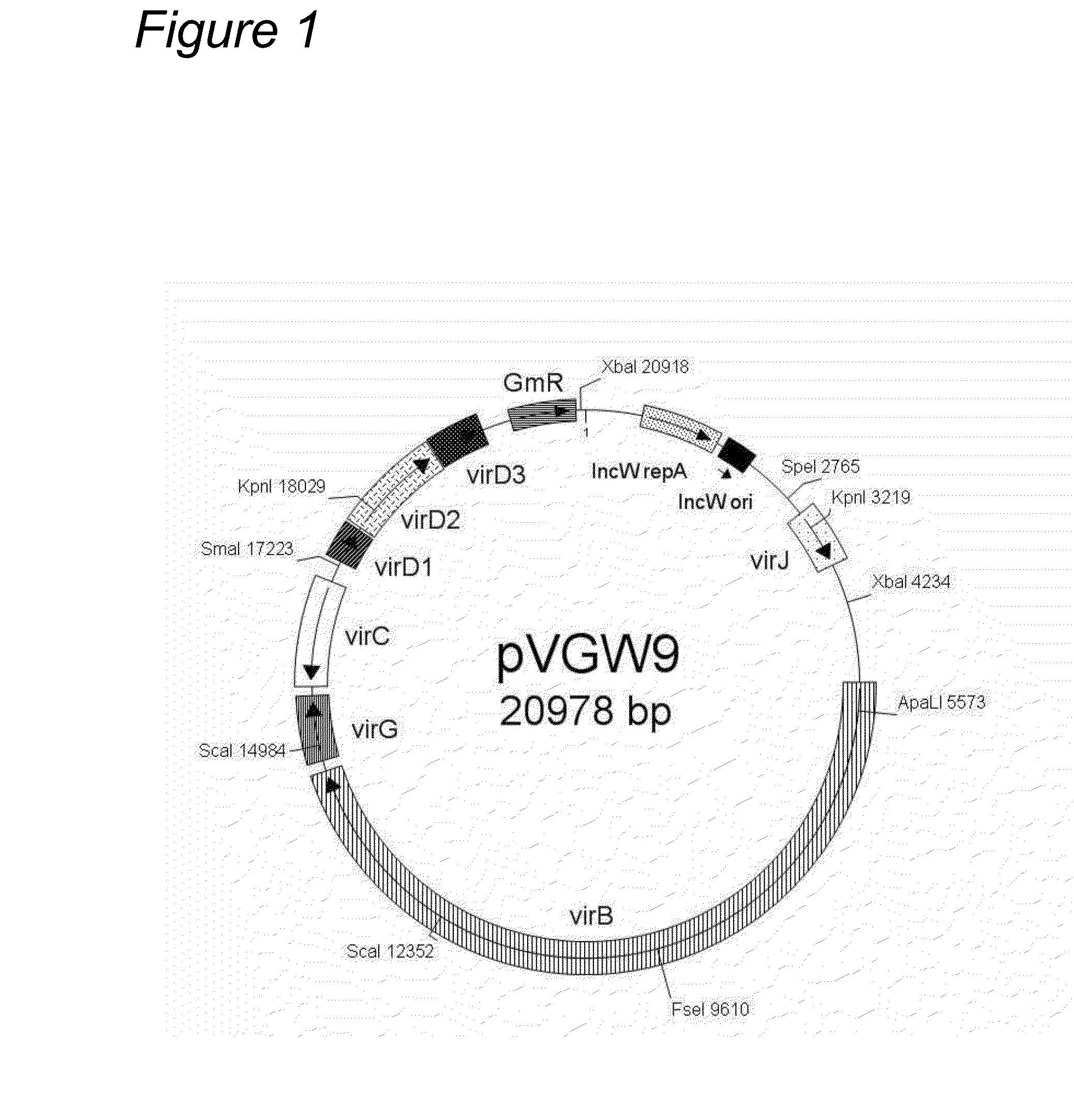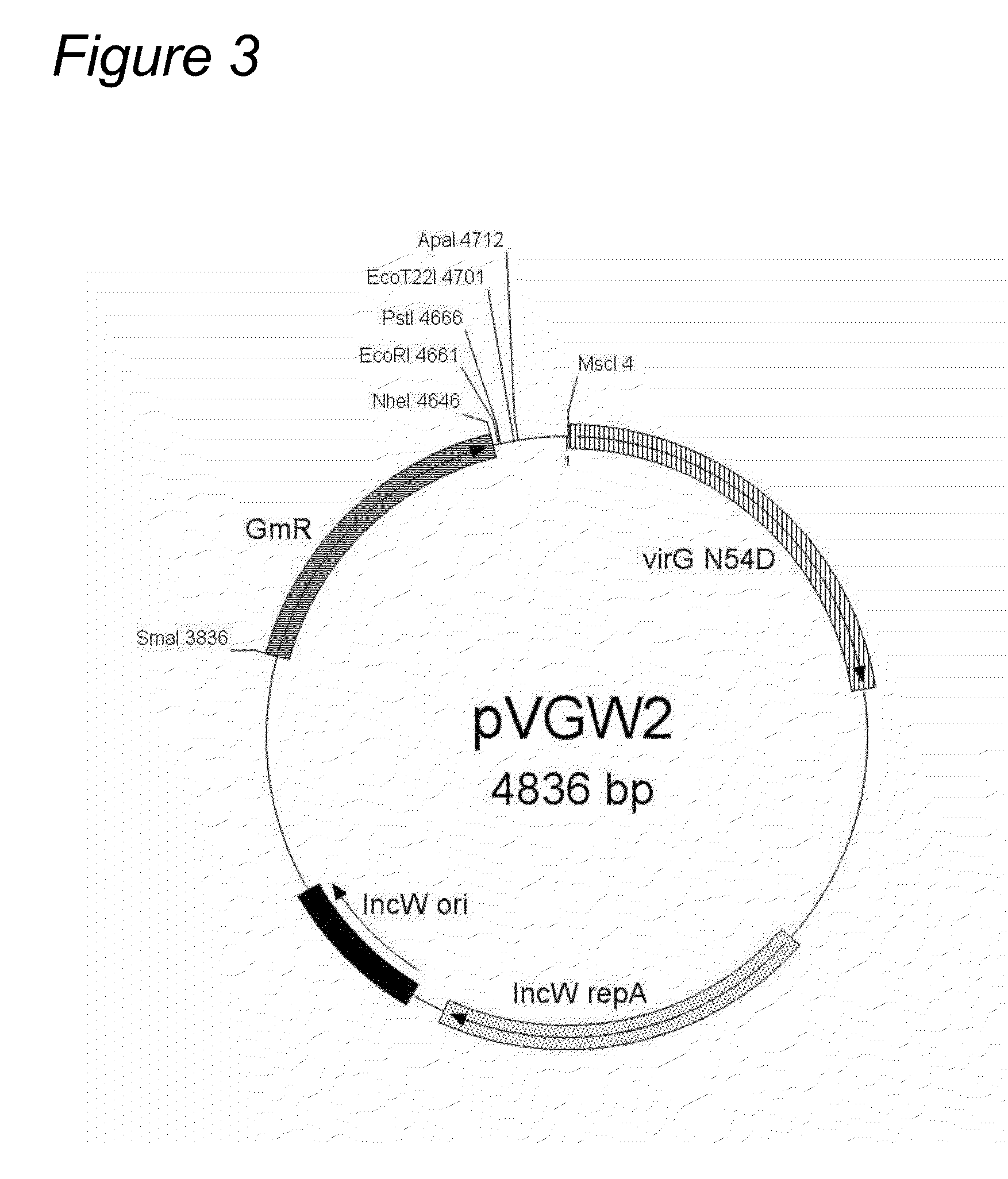Agrobacterium bacterium to be used in plant transformation method
a technology of agrobacterium and plant, applied in the field of agrobacterium bacteria, can solve the problems of low transformation efficiency, low conversion efficiency, and low conversion efficiency of plants, and achieve the effect of high conversion efficiency
- Summary
- Abstract
- Description
- Claims
- Application Information
AI Technical Summary
Benefits of technology
Problems solved by technology
Method used
Image
Examples
example 1
Construction of a Super Ternary Vector System
[0219]The present Examples describe constructing a vector system (super ternary vector system) using three types of plasmids of the present invention.
[0220]pTOK47 comprises both the IncW ori and the pBR322 ori, and its full length is 28 kb (Jin et al., 1987). Furthermore, the full length of pAL154 (Amoah et al., 2001) is 24 kb. These booster vectors are large plasmids that comprise many sequences that are unnecessary for maintaining replication in the Agrobacterium. The vector to be used as a booster vector in the super ternary vector system should be a shuttle vector that is desirably smaller in size, readily incorporates the vir region fragment, and can be cloned into E. coli. Patent Document WO2007 / 148819 A1 discloses a vector pVGW2 that suits these requirements. pVGW2 comprises both an IncW ori and a pBR322 ori, and it carries a gentamycin resistance gene (FIG. 3). In the present Examples, a booster vector having a virulence region of...
example 2
Gene Introduction into Maize A188 by Super Ternary Vector System
[0230]In the present Example, a super ternary vector strain LBA4404 prepared in Example 1 was used to introduce genes into maize A188.
[0231]Materials and Method
[0232]An immature embryo of maize of about 1.2 mm large in length (Variety: A188) was taken out aseptically from a greenhouse cultured plant, and it was immersed in a liquid media for suspending Agrobacterium, LS-inf (Ishida et al., 2007). After heat treatment at 46° C. for 3 min, the immature embryos were washed once in the liquid medium. Then, they were subjected to centrifugation at 20,000 G for 10 min. (4° C.), followed by immersion of the immature embryos in LS-inf medium containing 100 μmM of acetosyringone which contains suspension of the strains of LBA4404 (pLC41GWH-IG), GV2260 (pLC41GWH-IG), GV3850 (pLC41GWH-IG) and LBA4404 (pLC41GWH-IG / pVGW9), GV2260 (pLC41GWH-IG / pVGW9), GV3850 (pLC41GWH-IG / pVGW9) at a concentration of about 1×109 cfu / ml, after which th...
example 3
Transformation of Maize A188 by Super Ternary Vector Systems
[0236]Transformation of maize A188 was performed in the present Example by using the super ternary vector strain LBA4404 which was prepared in Example 1.
[0237]Materials and Method
[0238]Immature embryos of maize of about 1.2 mm in length (Variety: A188) were taken out aseptically from plants cultured in a greenhouse, and immersed in a liquid media for suspending Agrobacterium, LS-inf (Ishida et al., 2007). After heat treatment at 46° C. for 3 min, the immature embryos were washed once in the liquid medium. Then, they were subjected to centrifuge at 20,000 G for 10 min. (4° C.), followed by immersion of the immature embryos in a LS-inf medium containing 100 μM of acetosyringone which contains suspension of the strain of binary vector system LBA4404 (pLC41GWH-IG), and ternary vector system LBA4404 (pLC41GWH-IG / pVGW7), super ternary vector system LBA4404 (pLC41GWH-IG / pVGW9), and super binary vector system LBA4404 (pSB134) (Hiei...
PUM
| Property | Measurement | Unit |
|---|---|---|
| Electrical resistance | aaaaa | aaaaa |
Abstract
Description
Claims
Application Information
 Login to View More
Login to View More - R&D
- Intellectual Property
- Life Sciences
- Materials
- Tech Scout
- Unparalleled Data Quality
- Higher Quality Content
- 60% Fewer Hallucinations
Browse by: Latest US Patents, China's latest patents, Technical Efficacy Thesaurus, Application Domain, Technology Topic, Popular Technical Reports.
© 2025 PatSnap. All rights reserved.Legal|Privacy policy|Modern Slavery Act Transparency Statement|Sitemap|About US| Contact US: help@patsnap.com



